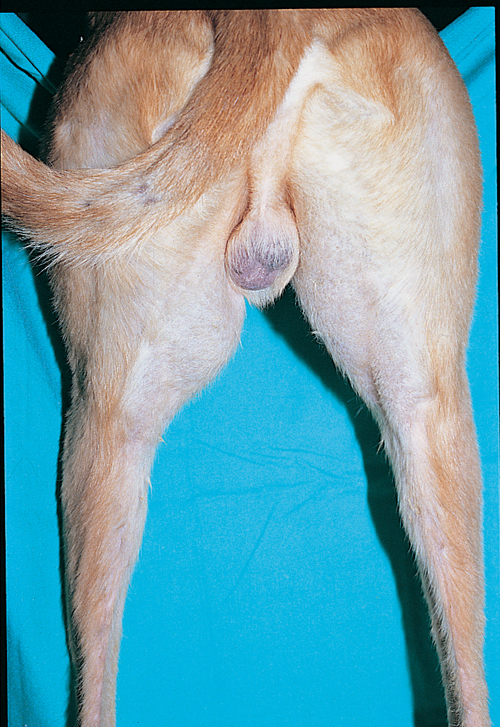Difference between revisions of "Small Animal Orthopaedics Q&A 10"
(Created page with "[[|centre|500px]] <br /> '''A photograph of a racing Greyhound with a muscular injury on the medial aspect of the left thigh just proximal to the stifle.''' <br /> <FlashCard...") |
|||
| (2 intermediate revisions by 2 users not shown) | |||
| Line 1: | Line 1: | ||
| − | [[|centre|500px]] | + | {{Manson |
| + | |book = Small Animal Orthopaedics Q&A}} | ||
| + | |||
| + | [[File:SmAnOrth 10.jpg|centre|500px]] | ||
<br /> | <br /> | ||
| Line 18: | Line 21: | ||
The avulsion usually involves the caudal portion of the gracilis muscle and can occur at either the muscle’s origin or the distal | The avulsion usually involves the caudal portion of the gracilis muscle and can occur at either the muscle’s origin or the distal | ||
myotendinous junction. | myotendinous junction. | ||
| − | |l1= | + | |l1=Muscle Strains and Ruptures |
|q2=What non-surgical treatments can be utilized in the first 48 hours following an injury such as this to reduce inflammation and hematoma formation? | |q2=What non-surgical treatments can be utilized in the first 48 hours following an injury such as this to reduce inflammation and hematoma formation? | ||
|a2= | |a2= | ||
| Line 29: | Line 32: | ||
Anti-inflammatory drugs can also be used to mitigate the inflammatory response. | Anti-inflammatory drugs can also be used to mitigate the inflammatory response. | ||
| − | |l2= | + | |l2=Muscle Strains and Ruptures#Treatment |
|q3=How should surgical repair of this lesion be | |q3=How should surgical repair of this lesion be | ||
performed? | performed? | ||
| Line 40: | Line 43: | ||
Although some surgeons advocate the use of non-absorbable suture materials, excellent results have been achieved using polydioxanone and polyglycolic acid suture materials. | Although some surgeons advocate the use of non-absorbable suture materials, excellent results have been achieved using polydioxanone and polyglycolic acid suture materials. | ||
| − | |l3= | + | |l3=Muscle Strains and Ruptures#Treatment |
</FlashCard> | </FlashCard> | ||
Latest revision as of 22:25, 24 October 2011
| This question was provided by Manson Publishing as part of the OVAL Project. See more Small Animal Orthopaedics Q&A. |
A photograph of a racing Greyhound with a muscular injury on the medial aspect of the left thigh just proximal to the stifle.
| Question | Answer | Article | |
| What muscle has been injured? | The left gracilis muscle has been avulsed as evidenced by the swelling in the caudomedial region of the thigh. Avulsion of the gracilis muscle is one of the most common and serious muscular injuries affecting racing Greyhounds. If not repaired early, this injury usually ends a dog’s racing career. The avulsion usually involves the caudal portion of the gracilis muscle and can occur at either the muscle’s origin or the distal myotendinous junction. |
Link to Article | |
| What non-surgical treatments can be utilized in the first 48 hours following an injury such as this to reduce inflammation and hematoma formation? | A cold compress, ice packs or cold spray should be applied to any muscle injury as soon as possible. Hypothermia causes vasoconstriction which reduces hematoma formation, swelling, edema and pain. Cold therapy should be applied for 15–20 minutes several times a day for the first 48–72 hours. A compressive bandage should be applied whenever possible. Restriction of movement and compression of the affected area helps to minimize inflammation and hematoma formation. Anti-inflammatory drugs can also be used to mitigate the inflammatory response. |
Link to Article | |
| How should surgical repair of this lesion be
performed? |
Surgical repair of gracilis muscle injuries involves hematoma removal, muscle debridement and placement of appositional sutures. Apposition of the bulk of the muscle parenchyma can be achieved with pulley or large horizontal mattress sutures. Numerous small horizontal mattress or cruciate sutures can be used to appose the muscle sheath. Although some surgeons advocate the use of non-absorbable suture materials, excellent results have been achieved using polydioxanone and polyglycolic acid suture materials. |
Link to Article | |
